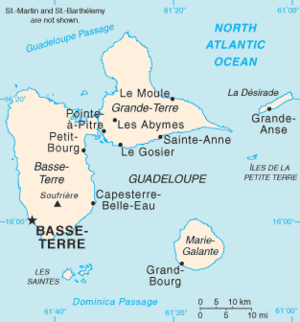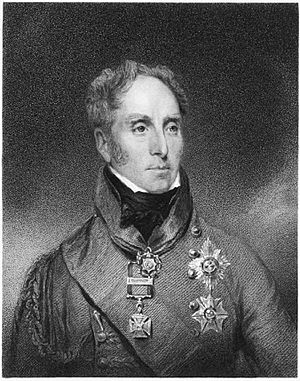Invasion of Guadeloupe (1815) facts for kids
Quick facts for kids Invasion of Guadeloupe |
|||||||
|---|---|---|---|---|---|---|---|
| Part of the Hundred Days | |||||||
 Map of Guadeloupe |
|||||||
|
|||||||
| Belligerents | |||||||
| Commanders and leaders | |||||||
| Strength | |||||||
| 5,000 2 corvettes 1 schooner 4 brig-sloops 2 sloops 1 brig 2 troopships 53 transports and hired ships |
6,000 | ||||||
| Casualties and losses | |||||||
| 16 killed 51 wounded 4 missing |
Unknown | ||||||
The Invasion of Guadeloupe was a short but important fight. It happened between French and British forces in August 1815. This battle was the very last conflict of the Napoleonic Wars. It took place right after Napoleon lost the famous Battle of Waterloo.
Contents
Why the Invasion Happened
Guadeloupe is an island in the Caribbean. The British had taken control of it twice before. The last time was in 1810. But the island was given back to France in 1814. This happened after Napoleon first gave up his power.
King Louis XVIII of France chose Admiral Charles-Alexandre Léon Durand Linois to be the island's governor. General Eugène Édouard Boyer de Peyreleau was his second-in-command.
Napoleon's Return Divides the Island
In February 1815, Napoleon escaped from exile on the island of Elba. News of his return reached Guadeloupe in May. This news caused a big split on the island.
- Admiral Linois stayed loyal to King Louis XVIII.
- General Boyer-Peyreleau supported Napoleon.
On June 15, a ship arrived from France. It carried orders to get Guadeloupe and Martinique to support Napoleon.
A Change of Loyalty
Boyer-Peyreleau tried to convince Linois to support Napoleon. But Linois refused. So, on June 18, Boyer-Peyreleau arrested important officials. He also put Linois under house arrest.
The next day, Linois unwillingly declared his support for Napoleon. However, they did not know that Napoleon had already lost the Battle of Waterloo on June 18. He would soon give up his power again.
Meanwhile, on the nearby island of Martinique, the governor, Comte Pierre de Vaugiraud, asked Britain for help. He wanted to keep Martinique loyal to the French King. British troops landed there in June to help.
The British Expedition to Guadeloupe
When the British commander in the West Indies, Lieutenant-General Sir James Leith, heard about Guadeloupe, he quickly put together a fighting force. Sir James Leith was a skilled soldier from the Peninsular War. Rear-Admiral Sir Philip Durham led the naval ships.
British and French Forces
General Leith's force included about 5,000 soldiers and artillery. They traveled on over 50 troop ships. Several British naval ships supported them. These included the Dasher, Fairy, Espiegle, and Columbia. There were also the sloops Muros and Barbadoes, and the brig Chanticleer.
Comte de Vaugiraud from Martinique also sent help. He provided two corvettes, a schooner, and French troops. The British soldiers were organized into three brigades. Major-Generals Sir Charles Shipley, Stehelin, and Douglass led these brigades. The troops came from several regiments, including the 15th, 25th, and 63rd regiments of foot.
Preparing for Battle
British naval forces took control of the Îles des Saintes on July 6. They then occupied the island of Marie-Galante on July 18.
The first group of British ships sailed from Carlisle Bay, Barbados, on July 31. They carried troops from South America and the Windward Islands. This group met the second group of ships, which had troops from St. Lucia, Martinique, and Dominica.
On August 2, the first group of ships anchored near St. Louis at Marie Galante. This made it look like they would land at Pointe-à-Pitre and Fort Fleur. The second group stayed near the Saintes, threatening Basse-Terre.
News of Napoleon's Defeat
Rumors that Napoleon had lost the war started reaching Guadeloupe in July. But Linois and Boyer-Peyreleau said these were just British lies.
On August 3, Captain Andrew Leith Hay arrived at Basse-Terre. He was General Leith's nephew. He carried a message saying Napoleon had given up his power. He demanded that the French soldiers surrender. But the French leaders refused. However, on August 7, French newspapers arrived from Barbados and Martinique. These papers had clear news from Europe.
The Battle for Guadeloupe
At dawn on August 8, the British 1st and 2nd brigades landed. They came ashore at Anse Saint-Sauveur. This was on the southeastern coast of Basse-Terre Island. The British soldiers pushed the French troops back into the hills.
The next day, August 9, the 3rd Brigade landed at Baillif. This was on the southwestern coast. This landing stopped the scattered French forces from getting back together.
Later that day, Admiral Linois asked the British for their surrender terms. The next day, August 10, he signed the surrender agreement.
After the Invasion
Guadeloupe remained under British control for a while. It was given back to France in April 1816. In November 1816, General Leith received the Order of Military Merit from France for his actions.


